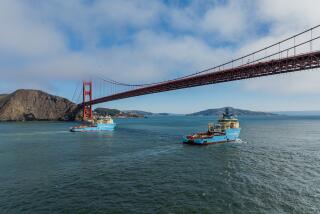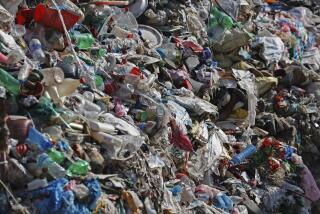U.S. Explorers Try to Stop Trashing Antarctica : Science: All the waste from McMurdo Station and the Amundsen-Scott South Pole Station is to be loaded onto a cargo ship and sent home for proper disposal.
- Share via
McMURDO STATION, Antarctica — Al Martin, manager of the largest scientific research station on this frozen continent, takes pride in the unsightly but well-organized piles of compacted and crated junk.
The trash awaiting removal includes a 7-million-pound backlog from years past. It is expected to be disposed of sometime within the next three or four years.
Everybody arriving at McMurdo must attend a briefing on what to do with the waste. Bins to segregate every imaginable kind of material are everywhere, inside buildings and on the slushy, unpaved streets outside.
At the peak of the austral summer, as many as 1,200 people live here. Workers and scientists alike are hammered with the same message: Keep the place clean.
McMurdo, which looks a lot like an old Western mining town on ice, is the hub of U.S. Antarctic research, operated by the National Science Foundation.
For the first time, at the end of this scientific season in late February, all waste materials from McMurdo and the U.S. Amundsen-Scott South Pole Station--more than 5 million pounds altogether--will be loaded onto a cargo vessel, the Green Wave, and shipped home. A private contractor in Washington state will handle the final disposal.
“For many years we treated Antarctica the way any town was treated back in the States,” said Dwight D. Fisher, senior foundation representative at McMurdo before his recent return to headquarters in Washington, D.C.
“For the most part, we’ve gotten rid of anything that has PCBs in it,” Martin said. “You almost have to see a before-and-after picture to see how much effort we went to.”
Even dirt and ice contaminated by spilled diesel fuel are scraped up and put in barrels for return to the United States.
At scientific field camps, restrictions are even tougher. Human waste is sealed in drums.
In the last five years, partly in response to pressure from environmental organizations, $42 million has been spent to clean up McMurdo.
“It’s an unmistakable shift that reflects the emphasis in our society, nationally and internationally,” said oceanographer Cornelius W. Sullivan, who is director of the foundation’s Office of Polar Programs. “We are no longer conquerors of the Earth. We are viewers of it.”
Until the last few years, McMurdo, which has been in operation since 1956, was a smoldering eyesore.
Trash and garbage were burned in an open dump. Waste-filled steel drums were plowed under. Worn-out machinery was towed onto the ice of adjoining Winter Quarters Bay. When the ice melted, the debris sank to the bottom.
Today the dump is gone, although residues of toxic materials remain in the ground. Some of them continue to leach into the bay. Once a rich haven for sea life, the small body of water has been virtually a dead pond since the 1970s. Discharge of diesel fuel from ships at an ice dock has contributed to the contamination.
A garbage-burning incinerator was installed in 1991. But the science foundation was forced to shut it down, at least temporarily, last June. A successful lawsuit brought by the Environmental Defense Fund charged that its toxic emissions were too high.
“It’s very difficult for me to believe that an incinerator operating on a continent that big can’t be quite effective, very energy-efficient and environmentally sound, particularly when you look at the alternatives,” said John S. Oliver of Moss Landing Marine Laboratories in California.
The alternative--”to load the waste on a ship, use all the energy to steam it back to our country, and either burn it there or bury it there--is just stupid,” Oliver said.
Sewage disposal is still a headache for McMurdo’s managers. Untreated frozen sewage is chopped up, mixed with warm brine and flushed underwater through a 160-foot-long pipe. Solid waste piles up on the ocean bottom. In late November, divers used high-pressure hoses to disperse it in “Operation Big Flush.”
Improvements in sewage treatment are being studied. Options include extending the disposal pipe into deeper currents of the Ross Sea or building some kind of treatment plant.
In 1991 the 26 nations conducting scientific research in Antarctica signed a protocol to strengthen environmental protection. The U.S. Senate approved the agreement in 1992; Congress may act this year on legislation to implement it.
Four bills have been introduced. Some would dilute the authority of the National Science Foundation and give more environmental oversight to other agencies, such as the Environmental Protection Agency and the National Oceanic and Atmospheric Administration.






